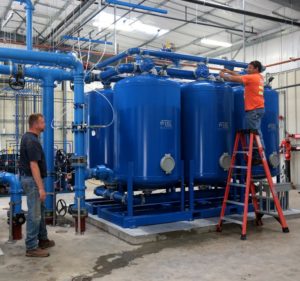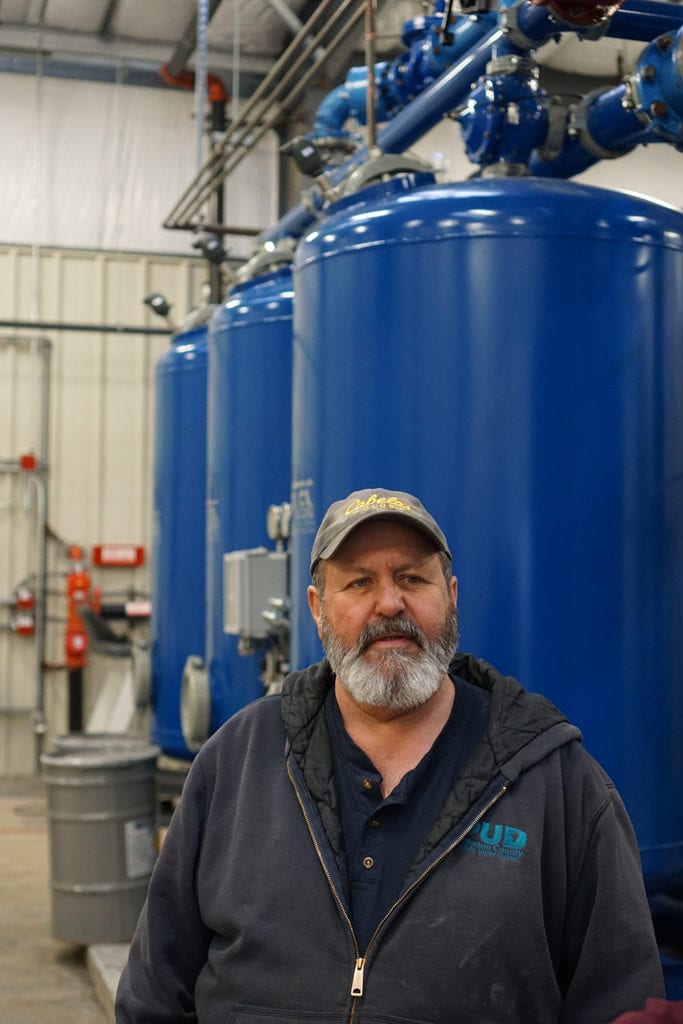How is PUD Water Treated?
Generally, we need to treat for iron and manganese in nearly all of our wells. Iron and manganese can affect the taste and appearance of water as well as stain everything from toilets to white linen. The treatment we prefer is a combined chemical cation exchange and mechanical process that requires very little chemicals (called ATEC). At the Sparling well site, we have both an ATEC process and a costly chemical process. Raw water at the Sparling site is often high in organic acids (from peat deposits underground) which can interfere with both the chemical and ATEC treatment processes. Recently at Sparling, we upgraded our treatment so that we can get more water out the door for each gallon we withdrawal from the ground.
Does the PUD Chlorinate Or Use Flouride?
Yes, in most of our systems, chlorine is required to adequately disinfect the water. Chlorine aids in the removal of iron and manganese, which are common minerals in our groundwater sources. We work hard to keep chlorine at the appropriate level that it does not cause taste problems. If you do smell a lot of chlorine, it is often an indicator that there is not enough chlorine in the system (indeed, this is the opposite of what one would think). Please call or email to tell us if you can easily smell chlorine (swimming pool smell). Some of our systems with deep well sources do not need chlorine. Gardiner is the best example of a source that does not require any treatment.
We do not fluoridate our water. Nor do we have any plans to do so at this time.
Is there Arsenic in Any of the Water?
There are traces of naturally occurring arsenic in almost all local waters. The EPA has determined that any quantity of arsenic in water presents some health risk. In January 2001 the EPA lowered the maximum contaminant limit of arsenic to 0.01 mg/l or 10 ppb. The PUD continually monitors its water sources to ensure they meet state and federal regulatory standards.
How Can I Find Out What is in Our Water?
Under the Clean Drinking Water Act we are required to test on a schedule for certain potential contaminants. The water quality test results performed for compliance with state and federal regulations are posted on the Department of Health’s Sentry Internet Database. Anyone can query the Sentry system by water system name or system number to find these results. Below is the list of our systems. Enter the name of the system, then click on the link. Click on “Samples” tab and look for the source number based on where you are. Click on “Exceedances” to see if samples tested over the maximum contaminant level (MCL). Note that most of the listed results are below the detection limit of the analytical method and are designated “LT”. For those samples that measured something in the water above the detection limit, it has an “EQ” next to it.
| System Name | General Area | Water System ID # | Active Source (pumping rate) |
| Quimper | Beckett Pt – Adelma Beach | 05783 | SO14, SO15 |
| Quimper | Port Hadlock | 05783 | S05, SO6 |
| Quimper | Chimacum | 05783 | SO5, SO20 |
| Quimper | Irondale | 05783 | S05, SO6, SO20 |
| Quimper | Marrowstone Island | 05783 | S06 |
| Quimper | Woodland Hills | 05783 | SO14 |
| Quimper | Kala Point | 05783 | SO18, SO19 |
| Quimper | Oak Bay/Eagle Ridge | 05783 | SO6 |
| Gardiner | Gardiner | 07877W | SO1 |
| Snow Creek | Snow Creek/Crocker Lake | 01220U | SO1 |
| Bywater Bay | Shine/Shine Plat | 02043 | SO1 |
| Bywater Bay | Bywater Bay | 02043 | SO2 |
| Quilcene | Quilcene/HWY 101 Corridor | AB292N | SO1 |
| Lazy C | Brinnon/Dosewallips RV Rd | 02676T | SO3 |
| Triton Cove | Triton Cove | 89470 | SO1 |
| Mats View | Mats Mats Bay west shore | 05536U | SO1 |
| Coyle | Coyle | 367115 | SO1 |
My Water Tastes Stale or Musky, What Do I Do?
Water at dead end lines can often taste bad, especially if those on the end of the line don’t use much water. Water needs to circulate to properly chlorinate as well as retain a favorable taste. If you find your water tastes stale or strange, call our front desk at (360) 385-5800 and we will dispatch one of our water crew members to fix the problem which usually requires us to flush water from the lines.
What is the Hardness of PUD Water?
Hard water is high in dissolved minerals, generally dissolved calcium and magnesium. Water hardness becomes noticeable when your hands feel slimy after washing with soap and water, or when your drinking glasses at home become less than crystal clear.
Below are sample results for hardness. Hardness is not a primary contaminant, but we do test it occasionally. Some sources have values that cycle by 10-20% with the highest concentrations occurring typically in late-fall. In the chart below, hardness is shown per system in mg/l and in grains. Hardness is not a frequently required water test and therefore the result dates may vary. Several water systems have multiple sources. All of our sources are groundwater and the amount of hardness can range significantly depending on which source is serving your service location.
| System Name | General Area | Hardness (mg/l) | Hardness (Grains) |
| Quimper | Woodland Hills (SO14) | 201 – 223 | 11.7 – 13.0 |
| Kala Point (SO18) | 169 – 173 | 9.9 – 10.1 | |
| Port Hadlock/Marrowstone (SO6) | 176 – 192 | 10.3 – 11.2 | |
| Irondale (SO6) | 176 – 192 | 7.6 – 9.2 | |
| Chimacum | 130 – 157 | 5.7 – 7.2 | |
| Bywater Bay | Shine Rd (SO1) | 98 – 124 | 5.6 – 7.2 |
| Bywater Way (SO2) | 116 – 140 | 6.8 – 8.2 | |
| Coyle | Coyle (SO1) | 76 – 93 | 4.4 – 5.4 |
| Gardiner | Gardiner (SO1) | 100 – 125 | 5.8 – 7.3 |
| Lazy C | Brinnon/Dosewallips River Rd (SO3) | 67 – 102 | 3.9 – 6.0 |
| Mats View | Mats Mats Bay (SO1) | 59 – 65 | 3.4 – 3.8 |
| Quilcene | Quilcene/HWY 101 corridor (SO1) | 92 – 106 | 5.4 – 6.2 |
| Snow Creek | Snow Creek/Crocker Lake (SO1) | 106 – 113 | 6.2 – 6.6 |
| Triton Cove | South of Brinnon (SO1) | 12 – 24 | 0.7 – 1.4 |

